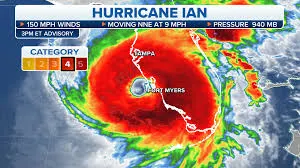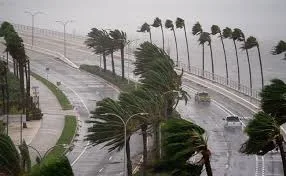Hurricane Ian
.jpg)
Continue to stay alert to continuing risks from Ian, including flooding, power outages, and storm-related debris. Widespread floodin is predicted along the southern east coast as Ian continues to move through.
Plan no to organiz for alternate shelter and power outages if you live in affected areas.
No state within the eastern U.S. has grown faster in recent years than Florida, which has added nearly 3 million residents since 20
Now, the state is once more in the path of a major hurricane, with Hurricane Ian expected to form landfall on Florida's western coast Wednesday. it's now classified as a Category 4 storm, consistent with the National Hurricane Center.
Tampa, Fort Myers, and Sarasota — all among the state's speediest growing metropolitan areas — are within the range of predicted paths, the NHC said. Ian may bring a "life threatening storm surge, catastrophic winds and flooding within the Florida peninsula," the hurricane center said in its 5 a.m. ET update.
More people — and more buildings to deal with them, often in coastal areas — mean that a serious hurricane could become more costly and destructive.
The population boom in hurricane-prone Florida is an example of the "expanding bullseye effect," said Stephen Strader, a professor at Villanova University who studies how human environments are susceptible to natural disasters.
.jpg)
Imagine an archer taking aim at a target, he explained. If the bullseye is extremely small, the chances of the archer hitting it are low. But because the target grows, the archer's odds improve.
"Instead of an arrow, we've hazard events like hurricanes and tornadoes. rather than having targets, we are the targets — our cities, our developed areas. And nowhere is that more readily seen than along our coastlines," Strader said.
Florida's population boom
At a time when increase has slowed to a crawl in most of the U.S., Florida has bucked the trend.
Of the country's major metropolitan areas, only Austin and Raleigh have grown faster than Orlando since 2010. Jacksonville and Tampa are #10 and #12, respectively.
The state's smaller cities are bursting, too. Since 2010, no eastern U.S. city with a minimum of 50,000 residents has grown faster than Fort Myers, the seat of the most important metropolitan area between Tampa and the Everglades, which added nearly 40% more residents therein time. Other areas like Port St. Lucie, Lakeland and therefore the Villages have grown quickly, too.
Most of the state's recent increase has come from domestic migration. within the year ending July 2021, nearly 221,000 Americans moved to Florida – a mean of more than 600 people each day, quite any other state.
People move to Florida for all types of reasons: year-round warm weather, comparatively cheap housing, no individual tax , and enormous communities of other retirees or immigrants, for instance.
"People are ready to look past the long-term risk and think about, 'Where do i would like to be for the next 10 years of my life?'" Strader said. "But there's also a gambling aspect thereto, and unfortunately, plenty of people are still willing to sit at the table."
More population means more damage
Officials have warned that Hurricane Ian could bring a storm surge of 10 feet or higher, together with 6 to 18 inches of rain. The geography of the Tampa-St. Petersburg area makes it especially vulnerable to a storm surge, experts said, and heavy rain could cause flooding even in inland areas.
With numerous more people living in the areas that could be affected, damage estimates are huge. Hurricanes are already the most expensive
natural disasters, and billion-dollar storms are happening more frequently than ever.
More than one million homes lay within potential reach of Hurricane Ian, consistent with one estimate released this week by CoreLogic, a property analytics firm. within the worst case scenario, the estimate found, the reconstruction value could total quite $258 billion.
The actual number is likely to be lower. And ever since 1992's Hurricane Andrew, Florida's code has required new homes to be more resilient to storms.
Still, a Category 3 storm in such a urban area could cause more than $100 billion in damage,
enough to put it among the four most costly storms in U.S. history.
"Hurricanes set the stage for disasters, but the severity and impact goes to be determined by societal elements – things like poverty and exposure, like what percentage people and how many homes are exposed, like construction quality," Strader said.
Newcomers mean officials must communicate effectively
Newcomers have to learn that hurricanes are "a part of living in Florida," said St. Petersburg Mayor Ken Welch.
"Folks who come to our state have to understand that when a storm like this comes, and you're in an evac area, you would like to have a plan and you need to move when asked to," Welch said in an interview with NPR.
The influx of newcomers means public communication about evacuation and shelters is vitally important, said Eren Erman Ozguven, the director of the Resilient Infrastructure and Disaster Response Center at Florida State University and Florida A&M University.
"There are Floridians that have seen numerous hurricanes over the last decades and who have muscle memory, and there are people who moved to Florida in the last decade. Many of them haven't seen a hurricane," he said.
Adding to the challenge is that a lot of the newcomers are retirees. "They may or might not have a smartphone, and that they may still rely on traditional communication such as radio or TV," Ozguven said.
The last major hurricane to hit western Florida was in 2017, when Hurricane Irma thrashed the eastern part of the Fort Myers-Cape Coral metro area; tens of thousands of people have moved to the area since then. In Tampa, no hurricane has hit the town directly in decades.
"hurricane lists"
"hurricane name list 2022"
"hurricane list 2022"
"ana hurricanes"
"hurricane Nicholas"

.jpg)


.jpg)




No comments:
Post a Comment